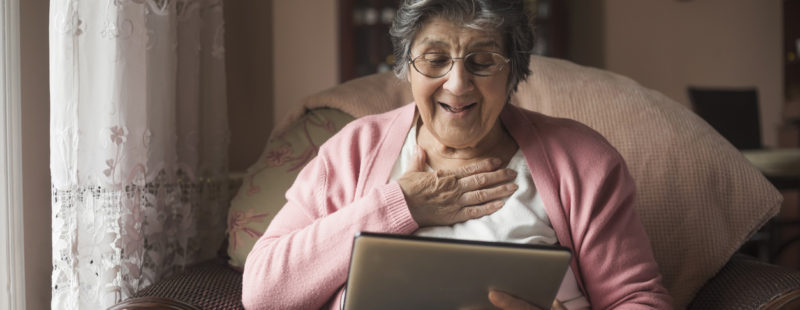The second webinar of our series on Loneliness in the time of Covid-19 focused on bridging the digital divide. Over 100 participants from charities, local government, academia, and health and care came together to talk about their experiences and learning. In this blog post, we reflect on the insights they shared.
An increase in digital interaction
In recent months we’ve seen a huge increase in digital interaction. With 7 in 10 people making at least one video call a week, including growing numbers of older people, digital technology has been a lifeline for many during lockdown.
But we know that many people are still not online – especially people who were already lonely or isolated before Covid-19 struck. In our webinar we talked about who is missing out, what this means for them, and what is lost as so much of life has moved online.
The event confirmed that people still face real barriers to getting online. And despite the hard work and creativity of organisations working on loneliness, these barriers can’t always be overcome.
Devices and connectivity
Many organisations are distributing connected devices such as tablets, laptops and phones. The DevicesDotNow campaign has delivered nearly 2,000 laptops and tablets since lockdown began, but demand still far outstrips supply.
Not everyone has access to broadband – especially people living in rural areas, where coverage can still be patchy, or in care homes, which rarely have wifi, and those on lower incomes, who may not have a home connection. In response organisations are providing pre-paid SIM cards or dongles, or helping with the cost of data.
Yet the equipment is just the first step. As one person at the webinar said, “for those who’ve taken the tech onboard it’s gone well – but that’s the minority.”
Confidence
Participants identified confidence as the biggest barrier people faced in getting online. Some older people, and particularly their family members, are concerned about scams and online safety.
However, the main issues were to do with reluctance to try something that might go wrong, and reticence about asking for help. This is in line with previous research into digital exclusion among older people, which highlights the importance of ongoing, face-to-face support to help people build confidence at their own pace.
Although lots of organisations already ran “IT buddy” schemes, this is much more challenging in lockdown. Some are moving to telephone support – providing people with a device, then calling to talk them through getting connected, but even this isn’t always enough.
Distant not digital
One of the clearest messages coming through our discussion was the importance of older means of communication – in particular, phones and letters – to help people stay connected when they are not online. As well as 1:1 befriending calls, we heard about existing groups staying in touch by WhatsApp, pen-pal schemes, and a community newsletter created using phone calls and postcards and distributed with food parcels.
Other organisations have posted activity packages to single mothers or people living alone, in place of the group activities they would otherwise have been supporting.
Inclusion
Whatever the medium, some people still face barriers to engagement, for example around language and accessibility. We heard how the Henna Asian Women’s Group has shifted all its services online while still ensuring provision in a range of languages. Organisations highlighted the challenges of reaching people with communications difficulties, whether due to hearing or sight loss, learning disabilities or cognitive impairment. With people with these conditions often more vulnerable to Covid-19, and potentially facing long term limitations on movement and social contact, it’s clear that we will need to find new ways to include them.
Not the long-term solution
Finally, there was a strong feeling that while online support is better than nothing, it cannot be a long-term substitute for face-to-face connection. Digital interactions miss out so much that can help build relationships and reduce the sense of loneliness – from non-verbal communication and touch to the chance of spontaneous, informal interaction over a cup of tea.
The easing of lockdown measures has allowed some return to face-to-face interaction – for example, doorstep befriending visits or socially distanced walks in the park – but for many people this is still not an option.
This matters even more for those who already lacked social connections. We heard that while digital interaction can sustain existing relationships, it is much harder to build new relationships online.
This is also a problem for service providers – when we can’t meet people face to face, getting to know them and providing the help they need is far more challenging. Building relationships and combating loneliness relies on trust – and this can be in short supply online. As we come out of lockdown, rebuilding this sense of trust and genuine engagement will be critical if we are to avoid many more people feeling disconnected and isolated.





No comments on this article yet. Please feel free to submit a comment below.
By submitting a comment you grant Campaign to End Loneliness a perpetual license to reproduce your words and name/web site in attribution. Inappropriate and irrelevant comments will be removed at an admin's discretion. Your email is used for verification purposes only, it will never be shared.